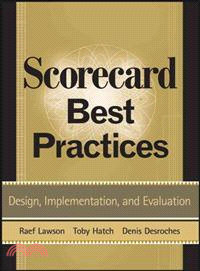| FindBook |
|
有 1 項符合
toby hatch的圖書 |
 |
$ 1537 | SCORECARD BEST PRACTICES
作者:RAEF LAWSON / 譯者:TOBY HATCH 出版社:JOHN WILEY & SONS,LTD 出版日期:2007-10-24 規格: / 精裝 / 208頁  看圖書介紹 看圖書介紹
|
|
|
- 圖書簡介
Scorecard Best Practices: Design, Implementation, and Evaluation expertly shows you how to bridge the gap between Scorecard theory and application through hands-on experiences and useful case studies. It is the one-stop resource you will turn to for the latest tools and know-how to implement corrective changes. Whether you are a CEO, CFO, CIO, vice president, or department manager, Scorecard Best Practices is the book you will keep at your fingertips to get your company running at maximum performance.
- 作者簡介
Raef Lawson, PhD, CPA, CMA, is Director of Research for the Institute of Management Accountants (IMA). He was formerly a professor and chair of the Accounting Department at the University at Albany, State University of New York. He has written extensively in the areas of scorecards, activity-based costing, and cost management, and his work has been published in a variety of publications.
Toby Hatch is a Domain Leader for Performance Scorecard and Business Modeling with Hyperion Solutions. Ms. Hatch has been involved with supporting and implementing scorecard systems, performance management solutions, and activity-based management solutions in companies around the world since 1988. Based on five years of research on implementing scorecard systems, she has published numerous articles in various magazines.
Denis Desroches is a Domain Leader in the business performance management field with Hyperion Solutions. Since 1993, he has supported organizations with the selection, implementation, and knowledge acquisition of scorecard, performance management, and activity-based management solutions. - 目次
Acknowledgements.
Chapter 1. Introduction.
Shaps Study Overview.
Study Analysis Groups.
Chapter 2. Scorecard Systems Overview.
What Is A Scorecard System?
Attributes Of Scorecard Systems.
Reasons For Implementing (Operational Versus Strategic).
Impetus For A Scorecard System Initiative.
Benefits Of A Scorecard System.
Best Practice Organization Benefits.
Achieving Significant Benefits: International Results.
Use Of Scorecard Systems By Demographic Segment, Size, Industry
What's Next?
Chapter 3. Establishing Motivation.
Background.
Impetus For Implementation.
Use Of Targets.
Linking Performance Measures To Compensation And Rewards.
Aligning Measures And Employees To Organizational Goals.
Advertising Success.
Measures Used.
Software Features Made Available.
Communicating Appropriate Reasons For Scorecard Implementation.
Summary.
Chapter 4. Enabling A Supportive Organizational Environment.
Background.
Have Buy-In From Top Level Management.
Articulate And Communicate The Organizational Strategy.
Define And Communicate The Reasons For And Benefits Of Implementing A Scorecard System.
Align Human Capital To The Strategy.
Have A Strategy Champion To Maintain The Visibility Required To Be Successful.
Have Employees That Accept And Use The System.
Use A Feedback Loop To Understand Progress And Make Changes Where Required.
Suitable Automation.
Eventually Link To The Compensation And Reward Systems.
Use Consultants Appropriately.
Provide Adequate Time To Implement And Realize Benefits.
Have A System That Is Pervasive, But Implemented In Phases.
Summary.
Chapter 5. Design Of A Scorecard System I: The Organizing Framework.
Organizing Framework.
What Is An Organizing Framework And Why Do We Need One?
Popular Frameworks.
Frameworks Typically Chosen.
Industry Example.
Can An Organization Have Multiple Frameworks?
Multiple Frameworks Or Management Initiatives?
Summary.
Chapter 6: Design Of A Scorecard System II: Other Issues
Background.
Ties Between Measures And Organizational Strategy.
Linking Compensation With Performance.
A Pervasive Scorecard System.
Tracking The "Right" Measures.
Does Your Costing System Support Your Scorecard System?
Self-Evaluation Questionnaire.
Summary.
Chapter 7. Implementation Strategies.
Communicating Scorecard Concepts
Selling The Scorecard.
Organization Levels.
Approaches To Implementation.
Impact Of Implementation Approach.
Industry Differences.
Framework And Levels Of Implementation.
Plans For Future Roll-Out.
Updating Scorecards.
Summary.
Chapter 8. Implementation Issues.
Implementation Timeframe And Deadline.
Implementation Timeframe And Reason For Scorecard System Deployment.
Implementation Timeframe And The Approach.
Effect Of Rationale On Implementation.
Number Of Measures.
Time To Implement Scorecard Software.
Use Of External Consultants.
Consultants And Scorecard Automation.
Organizational Buy-In.
Scorecard And Other Performance/Cost Management Tools.
Summary.
Chapter 9. Scorecard Automation.
Need For Automation.
Extent Of Data And Report Automation.
Software Options.
Software Deployment.
Reporting Results.
System Functionality And Features.
System Flexibility.
Data Accessibility.
Summary.
Chapter 10. Best Practice Considerations Checklist.
Best Practice Considerations Checklist.
Appendix. Case Studies.
Suzano Petroquimica.
Fujitsu Services Oy.
First National Bank: Banking Operations.
Hospitality Services Company.
Financial Service Company.
Pfizer.
City Of Boston.
Entertainment Subscription Company.
Glossary.
Index.
Acknowledgments.
|











